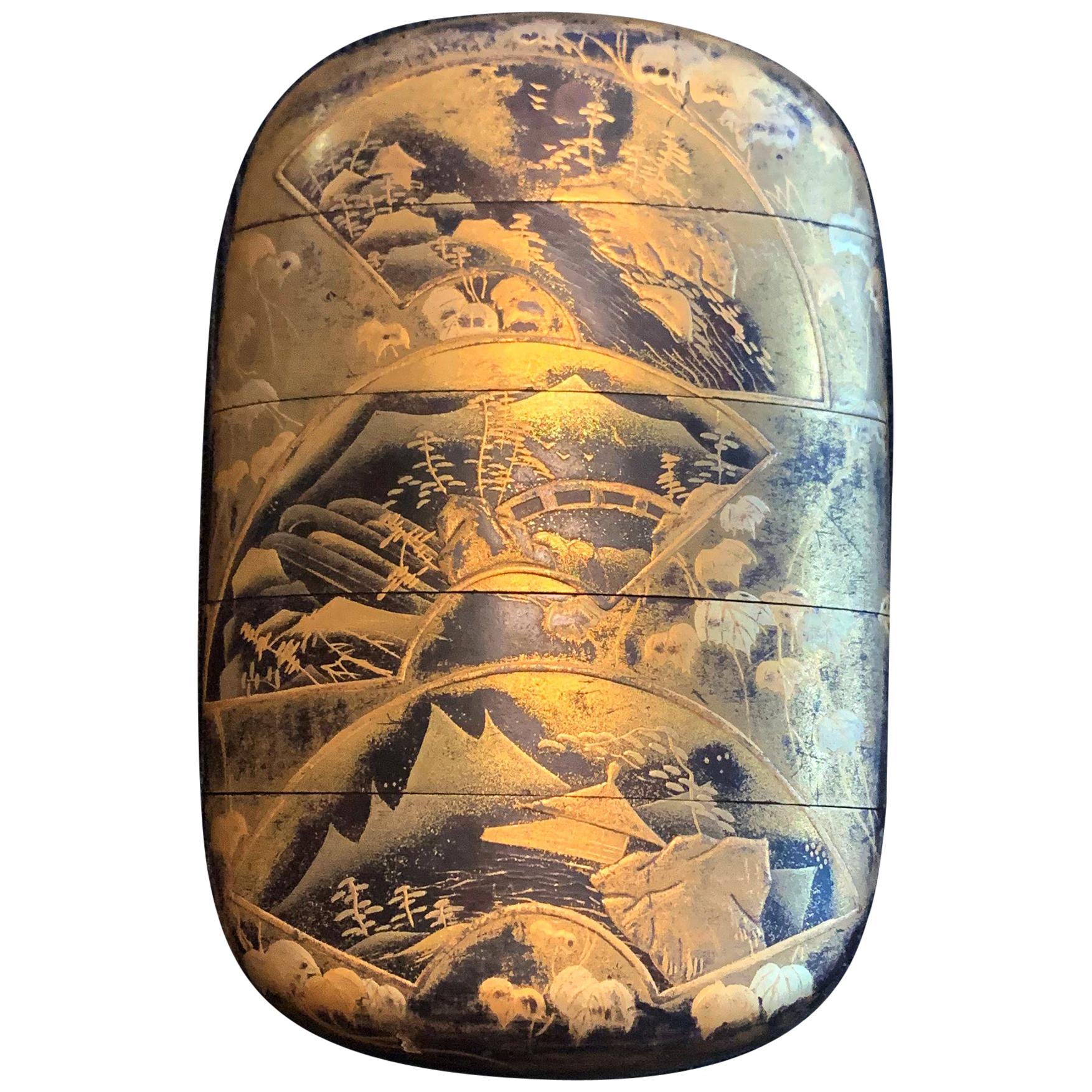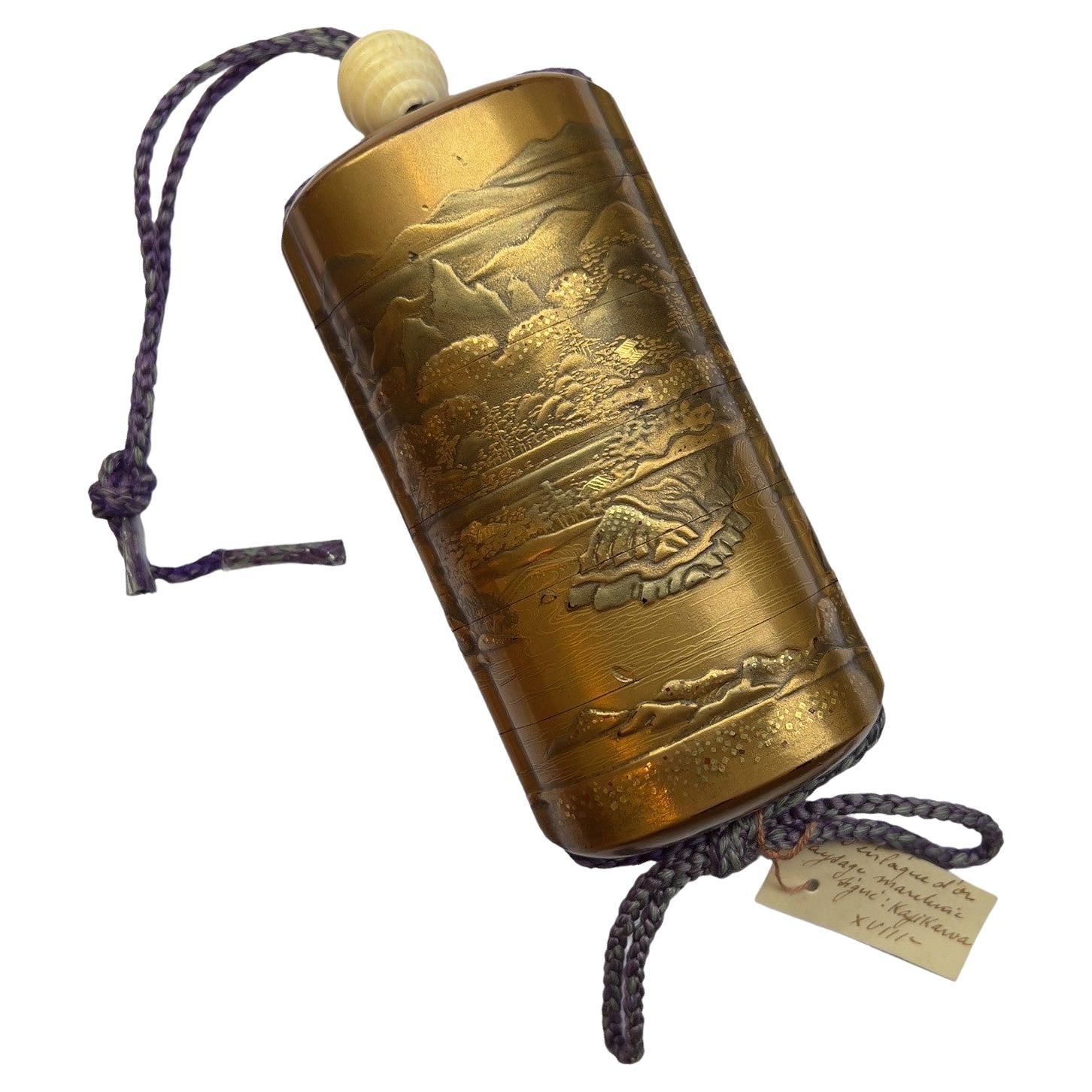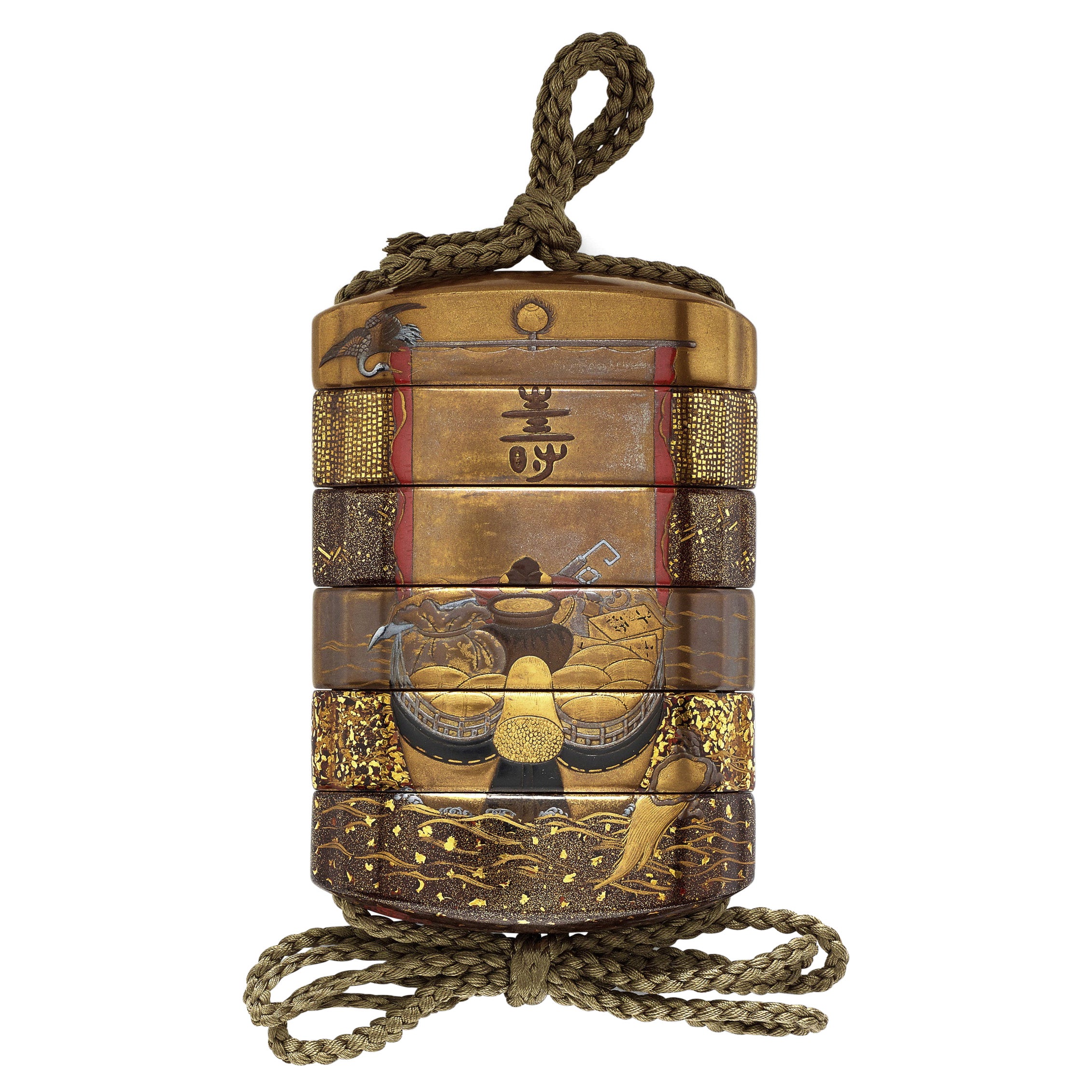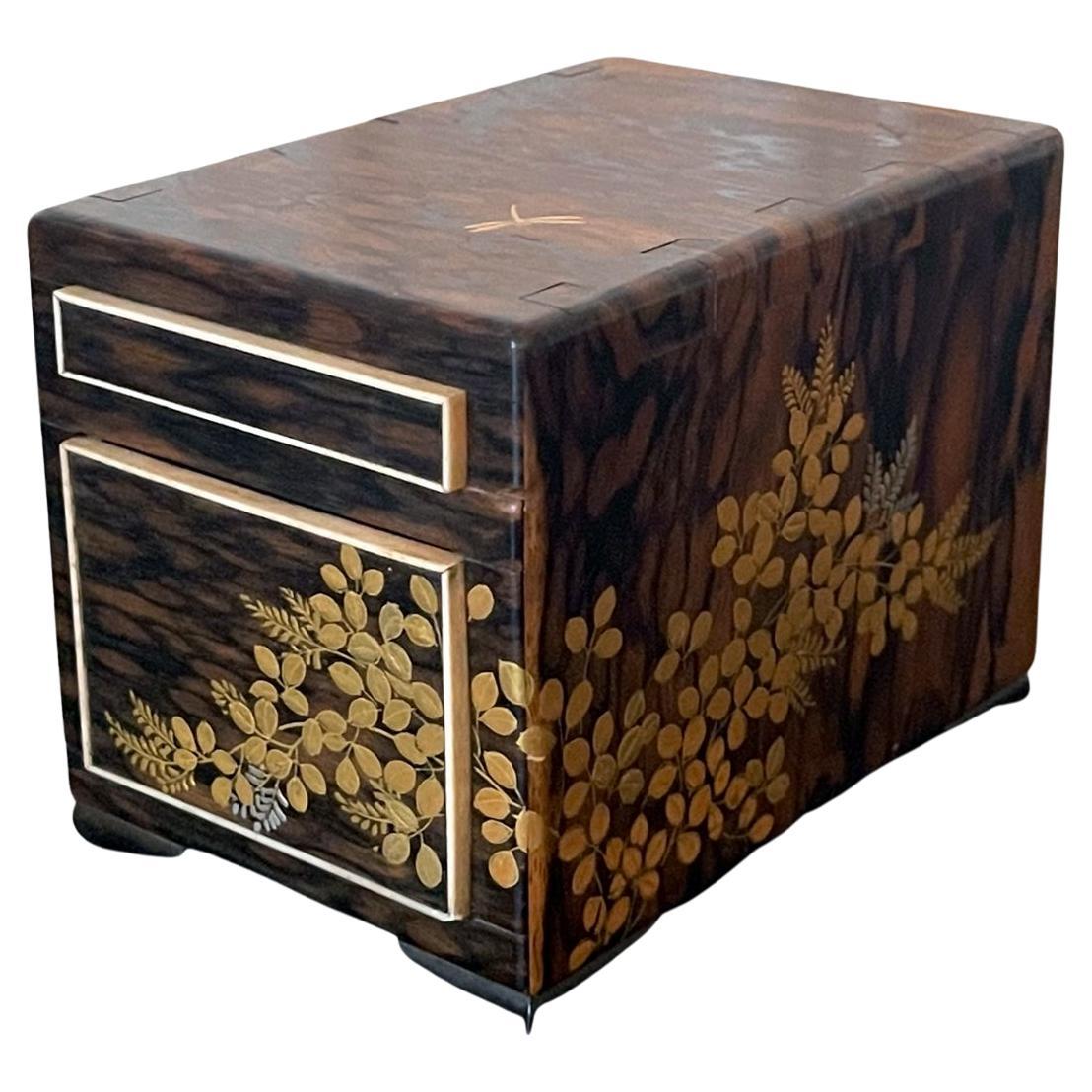Items Similar to Fine Japanese Lacquered Inro with Inlays by Kajikawa
Want more images or videos?
Request additional images or videos from the seller
1 of 18
Fine Japanese Lacquered Inro with Inlays by Kajikawa
About the Item
A Japanese four-case lacquer inro by a member of Kajikawa family circa 19th century (late Edo to early Meiji period). It depicts a nocturnal scenery of a meandering stream surrounded by bush clovers, where a full moon is reflected on the water. It was masterfully decorated in gold and silver maki-e using a combination of techniques including takamakie, togidashi and kirigane as well as aogai (abalone shell) inlays. The stream was set between the slightly elevated banks, adding to this piece a already strong three-dimensional composition. The interior was decorated in gold nashiji. It was signed on the bottom "Kajikawa Zou" (made by Kajikawa and a pot seal centered with "Ei" in Kanji. In one of the compartment, there is a katakana mark, appears to be a name, possibly the owner.
Kajikawa clan was one of the most famous lacquer artisanal family established in the 17th century. Many well known members over the generations produced lacquer art in a wide range of formats, but two third were signed only with the family name such as this one. It is therefore not possible to pinpoint the exact author of this piece.
Provenance: This inro was purchased as lot 349 in Christie's New York sale Japanese Works of Art. January 17th, 1980.
- Dimensions:Height: 3.5 in (8.89 cm)Width: 2.25 in (5.72 cm)Depth: 1 in (2.54 cm)
- Style:Japonisme (Of the Period)
- Materials and Techniques:
- Place of Origin:
- Period:
- Date of Manufacture:19th Century
- Condition:Wear consistent with age and use. Well preserved and very fine piece, with surface patina and minor general wear, a small nick on the interior contact on one case as shown.
- Seller Location:Atlanta, GA
- Reference Number:1stDibs: LU945021038042
About the Seller
5.0
Platinum Seller
These expertly vetted sellers are 1stDibs' most experienced sellers and are rated highest by our customers.
Established in 2006
1stDibs seller since 2010
478 sales on 1stDibs
Typical response time: <1 hour
- ShippingRetrieving quote...Ships From: Atlanta, GA
- Return PolicyA return for this item may be initiated within 2 days of delivery.
More From This SellerView All
- Fine Japanese Lacquered Inro by YutokusaiLocated in Atlanta, GAA four-case lacquered Japanese inro by Yutokusai (Gyokkei), a lacquer artist active from 1845-1900 (end of Edo to Meiji period). The slightly round inro features a very intricate design with three unfolded fans on the front and two on the back: each reveals a vignette landscape scenery, likely real places in Japan. Using a combination of hiramaki-e and slight takamaki-e, the artist deftly created the pictures with fine details, rendering the inro as a miniature artwork...Category
Antique 19th Century Japanese Japonisme Lacquer
MaterialsWood, Lacquer
- Fine Miniature Japanese Kodansu with Lacquer InlaysLocated in Atlanta, GAA fine Japanese miniature kodansu constructed from Kaki wood (Persimmon) circa 19th century, late Meiji period. With its expressive exotic wood grains and exposed tenon construction,...Category
Antique Late 19th Century Japanese Meiji Lacquer
MaterialsWood
- Rare Japanese Sumi-E Lacquer Inro Yamada Jokasai Edo PeriodLocated in Atlanta, GAA three-case lacquered Inro by Yamada Family circa 18th-19th century Edo period. The inro with slight rounded form is of Kano style and vividly depicts a dragon slithering among the ink clouds on a gold background. Sumi-e togidashi (ink togidashi) technique, in combination with Hiramaki-e, were employed to create the dreamy ambience of this piece. The dragon has a painterly appearance inspired by Chinese ink painting that was often seen on the Japanese folding screens. The back of the Inro was sparsely decorated with the shifting patterns of the darkening clouds with an emphasis on the space intentionally left empty. Jokasai was signed to the base. On the front of the inro there is another miniature signature Hakugyoku Hogen, which is one of names used by Kano Michinobu (1730-1790). The dragon is evidently one of his designs (see reference below). Established by a member of Yamada family in the 17th century, the clan was one of the most prominent lacquer artisanal family for the next 200 years until the end of Edo period in the 19th century. Most members signed their work simply with Jokasai making the identification of the individual artists somewhat impossible. The current Inro on offer, compared to many other pieces by Jokasai, has an uncommon Kano style done in Sumi-e togidashi. Another unusual feature of this piece is that the interiors of the inro was decorated with an interesting gold mosaic inlays (kirigane) on a dark lacquer background, giving it a jewel like quality. For another Inro by Jokasai of a similar style using Sumi-e togidashi but depicts a tiger, see Wrangham collection, no.353, which was offered for sale as lot 256 in Bonham's London Auction: The Edward Wrangham Collection of Japanese Art Part I. 9 Nov 2010. For an ink scroll...Category
Antique 18th Century Japanese Japonisme Lacquer
MaterialsWood, Lacquer
- Japanese Inro by Koma Koryu Edo PeriodLocated in Atlanta, GAA four-case lacquered inro by Koma Koryu circa 19th century late Edo period. The inro features a pair of Chinese mandarin duck resting under a bundle of blooming irises on the pond. ...Category
Antique 19th Century Japanese Japonisme Lacquer
MaterialsWood, Lacquer
- Unusual Japanese Lacquer Inkstone Box with MOP InlaysLocated in Atlanta, GAA Japanese black lacquer box with mother of pearl inlays circa early 20th century, end of Meiji period. It was likely to be used to store inkstone or other scholarly items. The piece displays several interesting characteristics that appear puzzling initially. First, the form is not typical Japanese, but more Chinese and Korean, with its scalloped base. Second, the decoration of MOP inlays also suggests a Korean and Chinese affiliation, especially with the linear borders and the scrolling cloud patters on the sides of the box. These two observations suggest that the box may be from Ryukyu Island instead of Japanese mainland. Third, strikingly in the center of the cover, a bold quarterly floral pattern outlined with MOP was filled with a striking mottled red lacquer using tsugaru nuri...Category
Early 20th Century Japanese Japonisme Lacquer
MaterialsWood, Lacquer
- Antique Japanese Inro by Shigehide Edo PeriodLocated in Atlanta, GAThis exquisite four-case lacquered inro was dated to the latter part of 18th century to early 19th century (Edo period) and made by Shigehide. The opposite sides of the inro together features a lavish flower arrangement in a bamboo basket (ikebana). The detailed craftmanship was a true pleasure to behold. Mostly Takamaki-e (high relief) were used to texturize the delicate petals of the chrysanthemums, on which different shades of gold were used to create contrast. Raden (mother of pearl) shells were also used to highlight some leaves, rendering the piece an interesting balance of color and material. The interior was completed in a mottled gold finish. It was signed Shigehide on the bottom with a Kao. There is a small carved rabbit ojime bead...Category
Antique Late 18th Century Japanese Japonisme Lacquer
MaterialsWood, Lacquer
You May Also Like
- Japan, Late 18th Century Gold Lacquer Inro by Kajikawa, Edo PeriodLocated in PARIS, FRLate 18th century Inro by Kajikawa. Edo period Beautiful inro in gold lacquer representing a continuous landscape on both sides. The interior in Nashiji lacquer. Some small traces...Category
Antique 18th Century Japanese Lacquer
MaterialsLacquer
- Five-Case Inrō 19th Century Signed Kajikawa Saku Japanese Lacquer BoxLocated in Milano, ITSigned: “Kajikawa saku” and with a red pot seal Height: 3 1/8in (7.9cm) Provenance: Michael Tomkinson Collection Leonard Haber Collection Literature: Michael Tomkinson, A Japanese Collection, London: George Allen, 1898, no. 300 Each case with slightly recessed joints and with different grounds, including kinji, nashiji, togidashi maki-e and gyobu-nashiji, on the obverse decorated with a treasure ship laden with the attributes of the Seven Gods...Category
Antique 19th Century Japanese Lacquer
MaterialsWood, Lacquer
- Gold Lacquer Inro Decorated with a Lake LandscapeLocated in PARIS, FRInro with four gold lacquer boxes, decorated with a lake landscape. Accompanied by a bronze ryusa manju. Small boxes formed of compartments that fit one on top of the other, inro (? ?) are traditional Japanese clothing...Category
Antique Mid-19th Century Lacquer
MaterialsLacquer
- Japan 1810 Kajikawa Edo Period Five Drawer Inro Lacquered Gilt Wood With RoosterLocated in Miami, FLJapanese Inro from the Edo period (1615-1868) created by Kajikawa. Beautiful Inro, created in Japan by one of the Kajikawa family during the Edo period (1615-1868), circa 1810. Has been carefully crafted in carved precious wood with applications of gilding maki-e and decorated with Japonism patterns. All dan trays are attached together with a himo cord. The detailed craftsmanship was a true pleasure to behold. Period: Edo period (1615-1868). Shogunate. Approximate Date: 1790-1810 Motif: A family of birds consisting of a cockerel, the hen and three chicks. Drawers: Five. Shape: Rectangular navette. Technique: Carved wood, lacquer and decorated in iroe-hiramaki-e on a gold ground. Ojime: 15mm 20mm, oval carved from natural translucent agate. Netsuke: None Weight: 47.70 Grams. Measurements: Inro is 78 mm by 55 mm by 18 mm (3.07 x 2.17 x 0.71 Inches). Signatures: Kajikawa Saku, in the underside with the signature KAJIKAWA. By a member of the Kajikawa family, signed Kajikawa 梶川 Japan, late 18th century to early 19th century, Edo period (1615-1868). The Kajikawa family Kajikawa family, flourished in the 19th century, they was Japanese lacquerware artists whose school in Edo (now Tokyo) flourished for more than 200 years. This family is perhaps the most famous of all the dynasties of Japanese lacquer artists, and certainly the name most often found on inro. The family is said to have been founded by Hikobei at Edo in the early 17th century, although some claim that the family’s great reputation really stemmed from his son and pupil Kyujiro. In any event, Hikobei worked for the shogunate, as did his successors until well into the 19th century. Kijirō excelled in designing particularly delicate lacquer inrō, portable medicine cases...Category
Antique 1810s Japanese Edo Lacquer
MaterialsAgate, Gold
- A Japanese maki-è lacquer inroLocated in Milano, ITJapanese inro with two compartments, in maki-è lacquer with nashiji decorations and circular reserves depicting flowers and leaves. Coral colored ojime and lacquer manju netsuke. Si...Category
Antique Mid-19th Century Japanese Japonisme Lacquer
MaterialsLacquer
- Fine Japanese Export Red Lacquer Box with Masonic Symbols, circa 1800Located in Amsterdam, NLA fine Japanese export red lacquer box with Masonic symbols Kyoto/Nagasaki, 1800-1820 Red lacquer decorated with scattered flowers and flying birds with long tails in gold, wit...Category
Antique Early 19th Century Japanese Edo Lacquer
MaterialsGold
Recently Viewed
View AllMore Ways To Browse
Lacquer Brown
Antique And Fine Art
Lacquer On Wood
New Lacquered Furniture
Lacquer Signed
Japanese Works Of Art
Inlay Wood Art
Furniture With Gold Inlay
Shell Inlay
Antique Japanese Marks
Japanese Antique Marks
Sale Japanese
Japanese Pot
Antique Shell Signs
Antique Shell Sign
Asian Inlay Art
Japanese Shell
Japanese Lacquer Meiji





